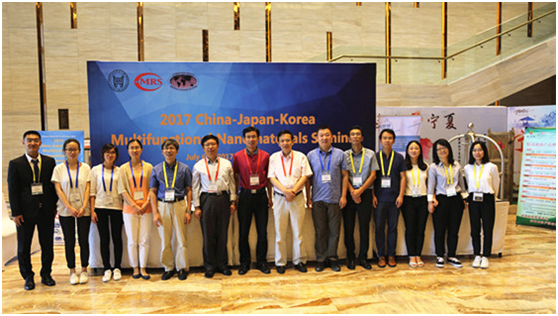2017 China-Japan-Korea Multifunctional Nanomaterials Seminar
From July 6th to July 9th 2017, the “2017 China-Japan-Korea Multifunctional Nanomaterials Seminar” was successfully held in Yinchuan, China. The conference was hosted by the University of Science and Technology Beijing, the China Society for Materials Research and the International Federation of Materials Research, and it was supported by the National Natural Science Foundation of China, the Korea National Research Fund, the Korea Society for Materials Research and the Japan Society for Materials Research. The conference brought together more than 200 experts, scholars and young scientific and technological specialists from China, Japan and South Korea, with the goal of promoting discussion on the preparation of nanomaterials, new functional research and the development of practical applications. At its conclusion, the Seminar showed growing interest in the multifunctional nanomaterials field and its importance to the academic community.

Multifunctional nanomaterials mainly use its sound, light, electricity, magnetic, thermal features to function. They can be found in various applications including electromagnetism, photo-catalysts, lithium-ion batteries, semiconductors, display materials, biomedicine, solar cells, fuel cells, thermoelectric materials and other prevalent scenarios, thus creating enormous social and economic value for mankind. With the development of technology and society, multifunctional nanomaterials span across a number of disciplines, including physics, chemistry, mathematics and engineering, with recent years seeing this list growing to include biology, medicine, environmental science and other related fields. As such, the impact of multifunctional nanomaterials extends from micro to mesoscopic to the macro, covering everything from basic science to advanced engineering. With the deepening of research and application of multifunctional nanomaterials, the new properties of nanomaterials will continue to bring significant benefits and opportunities to the current industry and will also create great changes and wealth for society. China has significant advantages in nanomaterials fields such as electromagnetism, photo-catalysts, biomedicine, and solar cells, while South Korea and Japan have the their own advantages in fields such as semiconductors, display materials and lithium ion batteries. For multifunctional nanomaterials in general, China and Japan have major prospects for cooperation and development potential.

The conference was co-chaired by Professor Soo Wohn Lee, Chairman of the International Materials Research Consortium, and Professor Han Yafang, First Vice Chairman of the International Materials Research Consortium and Secretary General of the China Society for Materials Research. The opening ceremony was presided over by Professor Jiang Yong from the School of Materials Science and Technology at USTB. Professor Soo Wohn Lee then gave a speech to the conference, where he introduced the current situation of multifunctional nanomaterials research and industry development, and discussed the prospects of further cooperation between China, Japan and South Korea, both in terms of research and academic collegiality.

The conference consisted of ten conference reports, five sub-forums and a three-part presentation, all of which discussed the basic principles and basic properties of multifunctional nanomaterials, the physical and chemical properties of nanostructures, and the design and manufacturing techniques of nanostructures. Furthermore, the Seminar explored the materials industry, potential applications for this field, advanced multifunctional nanomaterials structure, and gave you students the opportunity to contribute via a Young Scientists Forum. Afterwards, distinguished guests from all three countries voted on the six best student posters, after which the selected students were presented with a certificate by Professor Soo Wohn Lee and proceeded to take a picture.

The Seminar’s highlights focused on multifunctional nanomaterial applications such as photocatalysis, electromagnetism, displays, semiconductors, biomedical applications, lithium batteries, solar energy, thermoelectricity and composite materials. Meanwhile, the goal of the academic exchanges was to provide a strong platform to enhance young scientists and professors, while simultaneously encouraging cooperation between China, Japan and South Korea in order to establish the cornerstone for further long-term cooperative research projects.
Finally during the conference, Professor Jiang Yong from USTB, Professor Tohru Sekino of Osaka University and Professor Soo Wohn Lee of Korean University of Korea, participated in an interview with Xinhua News Agency to discuss the Seminar and its objectives.



